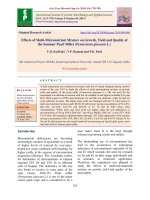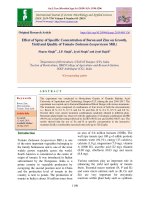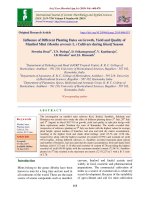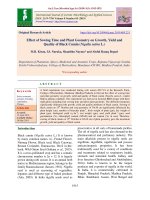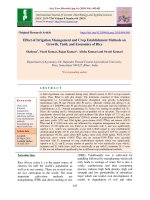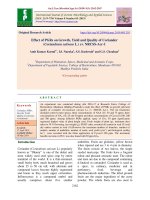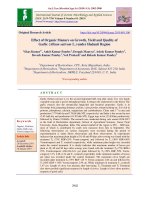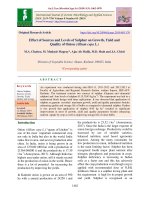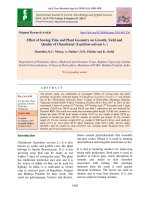Effect of micronutrient mixture formulation on growth, yield and quality of guava
Bạn đang xem bản rút gọn của tài liệu. Xem và tải ngay bản đầy đủ của tài liệu tại đây (205.92 KB, 6 trang )
Int.J.Curr.Microbiol.App.Sci (2020) 9(5): 2017-2022
International Journal of Current Microbiology and Applied Sciences
ISSN: 2319-7706 Volume 9 Number 5 (2020)
Journal homepage:
Original Research Article
/>
Effect of Micronutrient Mixture Formulation on Growth, Yield
and Quality of Guava
D. Janaki*, S. Prabhu, R. Poorniammal and J. Kannan
Horticultural College & Research Institute, TNAU, Periyakulam -625 604, Tamilnadu, India
*Corresponding author
ABSTRACT
Keywords
Fruit crop,
Micronutrient
deficiency,
Enriched MN
mixture
Article Info
Accepted:
15 April 2020
Available Online:
10 May 2020
Guava is one of the important fruit crop cultivated all over India. A guava plant shows micronutrient
deficiency which could be responsible for lesser yield and quality. Foliar feeding of nutrients to fruit
plants has gained much importance in recent years which is quite economical and obviously an ideal
way of evading the problems of micronutrients availability and supplementing the fertilizers to the
soil. The present investigation was conducted at Horticultural College & Research Institute,
Periyakulam during 2018-2019. The experiment was raised on well-established orchard of 3 years
old Lucknow -49 guava trees which are planted at 3.0 x 1.5m spacing. The experiment was laid out
in Factorial Randomized Block Design (FRBD) with five treatments replicated four times with two
different grades. The results revealed that the application of RDF + Enriched MN Mixture
(Soil)@2kg/tree + Foliar spray of % (T3) recorded highest fruit yield of 47.90 t ha-1 ,
followed by T1 recorded next highest fruit yield of 37.60 t ha-1while the control (T4) recorded the
lowest of 19.60 t ha-1 , The treatment T3 recorded the highest in quality parameters with reducing
sugar(8.02%), non-reducing sugar(6.93%) and lowest acidity(0.42%) Hence application of grade I
RDF + Enriched MN Mixture (Soil)@2kg/tree + Foliar spray of % can be advocated in
increasing the yield and quality of Guava
Introduction
Concept of global village and advances in
technology enable exporters to supply
markets around the world with high quality
product. To compete in domestic as well as
foreign market requirements, quality fruit
production is becoming a major objective of
the day in fruit industry.
The tree crops, grown under field conditions
are subjected to numerous nutrients
deficiencies which influence the tree growth,
tissue composition, fruit production and
quality. Nutritional deficiencies are closely
associated with the poor plant growth, fruit
set, heavy fruit drop, inferior quality of
produce. The average productivity of fruits in
India is low as compared to many fruit going
countries in the world. The area under guava
in India is 235.6 thousand ha and production
is 3198.3 thousand metric tonnes with a
productivity of 13.6 metric tonnes/ha.
Micronutrient plays an important role in
production and its deficiency leads in
lowering the productivity (Singh, 2001).
2017
Int.J.Curr.Microbiol.App.Sci (2020) 9(5): 2017-2022
Guava is rich source of vitamin C, vitamin A,
vitamin B12 (Riboflavin) and minerals like
calcium, phosphate and iron. The vitamin C
content of Guava fruit is 212 mg/100 g and
pectin content (1.15%). Zinc deficiency
results in interveinal chlorosis, formation of
little leaves and restricted internodes leading
to "rosette".
Much of interest in common guava has been
due to its delightful taste and flavour. It is the
fruit that has been often referred as “Apple of
tropics.” Bronzing in guava is a complex
nutritional disorder.
When fruiting starts in a soil marginal in P
and K, the nutrients are mobilised from older
leaves to the fruits, causing bronze coloured
leaves
which
results
in
reduced
photosynthate, transfer to the roots and
reduced uptake. Spraying of 0.3% boric acid
10-15 days before flowering correct the
deficiency.
The experiment was laid out in Factorial
Randomized Block Design (FRBD) with five
treatments replicated four times with two
different grades.
The treatments comprised of T1 as RDF +
Enriched MN Mixture (Soil) @2kg/tree, T2–
RDF + Foliar spray of %,T3- RDF
+ Enriched MN Mixture (Soil)@2kg/tree +
Foliar spray of %, T4 – Farmers
practice
(300:200:200g
Urea,
Super
Phosphate, potash/tree), T5- RDF (Without
MNM) The foliar application of these
treatments was made at three times of new
flush, 30 and 60 days after flowering.
Results and Discussion
The soil is sandy loam with deep red in loam
with irugur series. The initial soil was neutral
in reaction with pH of 7.75 and EC of 0.34 dS
m-1. The available N was low (248 Kg ha-1),
medium in available P (20.3 kg ha-1) (Table
1).
In general, foliar applications of 0.5 per cent
zinc sulphate and 0.4 per cent boric acid 10 to
14 days before flowering effectively eliminate
the zinc and boron deficiencies. Hence
present investigation was carried out to
evaluate
the
micronutrient
mixture
formulation in guava on growth, yield and
quality.
The available K was medium (185kg ha-1).
The exchangeable Ca was 3.4 mg/kg,
exchangeable Mg of 5.2 mg/kg With regards
to available micronutrients Fe was high 10.4
ppm, deficit in Zn (0.23ppm), the available
Cu and Mn was 0.80ppm and 0.46 ppm
respectively.
Materials and Methods
Floral characters
The experiment was conducted at Central
Farm,
Department
of
Fruit
crops,
Horticultural
&
Research
Institute,
Periyakulam
during
2018-2019.
The
experimental site was fairly uniform with
gentle slope. The soil was red soil, sandy
loam in texture, and having good drainage.
The experiment was conducted on wellestablished orchard of 3 years old Lucknow 49 guava trees which are planted at 3.0 x
1.5m spacing.
Application of RDF + Enriched MNM (Soil)
@ 2kg/tree + Foliar spray of MNM @0.3%
(T3) recorded Flowering (33.8%), Fruit
retention (50.4%) while lowest was recorded
in T4( Farmers practice) with 27.65% in
flowering and fruit retention of 37.40%
(Table 2).
As regards to grade, grade I recorded highest
flowering and fruit retention with a value of
31.50% and 43.56% respectively.
2018
Int.J.Curr.Microbiol.App.Sci (2020) 9(5): 2017-2022
Among the combination of grade x treatment
(G1T3) recorded the highest in flowers/ shoot
(34.8%) and fruit retention (52.80%).
Fruit characters
micronutrients alone along with soil has been
reported by several workers from different
parts of country viz., Meena et al., (2005),
Trivedi et al., (2012) which supports the
results obtained in present investigation.
Among the treatments, treatment (T3) RDF +
Enriched MNM (Soil) @ 2kg/tree + Foliar
spray of MNM @0.3%
recorded highest
Fruit diameter (7.82cm) and yield (43.7 t /ha)
while lowest was recorded in T4 (Farmers
practice) with Fruit diameter(6.82cm) and
yield(19.6 t/ha) (Table 3).
Minimum yield in control treatment is
obvious and it may be due to non-availability
of nutrients required for formation and
development of fruits resulting in production
of minimum number of fruits and less weight
of fruit in turn leads to production of lowest
yield in this treatment
As regards to grade, grade I recorded highest
Fruit diameter and yield with a value of
8.37cm and 36.94 t/ha respectively.. Among
the combination of grade x treatment (G1T3)
recorded the highest in yield/ha of 47.9t/ha.
Quality analysis
The production of more number of fruits per
tree in this treatment could be due to zinc and
iron which act as catalyst in the oxidation and
reduction process and is also of great
importance in the sugar metabolism thus
increased the yield per tree. Increase in yield
of guava fruits due to foliar application of
TSS and reducing sugar
The maximum TSS (12.80Brix ) and reducing
sugars (8.02%) was recorded in the treatment
T3 (RDF + Enriched MNM (Soil) @ 2kg/tree
+ Foliar spray of MNM @0.3%)
while
minimum values of these parameters were
noticed in the control T4 (Farmers practice)
with TSS (11.10brix ) and reducing sugars
(6.52%)
while the other treatments shows
the intermittent values (Table 4).
Table.1 Initial soil characteristics of experiment field
Particulars
pH
EC(dS m-1)
Organic carbon (%)
Nitrogen(kg ha-1)
Phosphorus (kg ha-1)
Potassium(kg ha-1
Calcium(mg kg-1)
Magnesium mg kg-1)
Iron(ppm)
Copper(ppm)
Manganese(ppm)
Zinc(ppm)
2019
Value
7.75
0.34
0.47
248
20.3
185
3.4
5.2
10.4
0.80
0.46
0.23
Int.J.Curr.Microbiol.App.Sci (2020) 9(5): 2017-2022
Table.2 Effect of micronutrient mixture on flowering and fruit retention of Guava
T.No
Treatment Details
T1
RDF + Enriched
MNM@ 2kg/ tree
RDF+0.3% foliar spray
RDF + Enriched
MNM@ 2kg/ tree
+0.3% foliar spray
Farmers practice
RDF without MNM
Mean
T2
T3
T4
T5
SEd
CD(5%)
Flowering %
G1
32.60
G2
30.00
Mean
31.30
G1
45.20
Fruit retention
( %)
G2
43.40
31.40
34.80
28.30
32.80
29.85
33.80
41.20
52.80
39.60
48.00
40.40
50.40
28.50
30.2
31.50
T
0.13
0.28
26.80
28.5
29.28
G
0.21
0.45
27.65
29.35
38.30
40.3
43.56
T
0.27
0.58
36.50
38.2
41.14
G
0.42
0.91
37.40
39.25
T xG
0.29
0.63
Mean
44.30
T xG
0.60
1.29
Table.3 Effect of micronutrient mixture formulation on fruit characters and yield in Guava
T.No
Treatment Details
T1
RDF + Enriched MNM@ 2kg/
tree
RDF+0.3% foliar spray
RDF + Enriched MNM@ 2kg/
tree +0.3% foliar spray
Farmers practice
RDF without MNM
Mean
T2
T3
T4
T5
SEd
CD(5%)
Fruit diameter(cm)
G1
G2
Mean
8.54
6.32
7.43
G1
43.20
8.33
8.99
6.15
6.65
7.24
7.82
41.60
47.90
30.80
39.50
36.20
43.70
7.84
8.17
8.37
T
0.06
0.14
5.80
6.04
6.19
G
0.10
0.22
6.82
7.10
20.00
32.00
36.94
T
2.31
4.96
19.20
30.00
30.30
G
3.66
7.85
19.60
31.00
TxG
0.14
NS
Yield (t/ha)
G2
Mean
32.00
37.60
TxG
3.42
6.89
Table.4 Effect of Micronutrient mixture formulation on quality characters in Guava
T.No
Treatment Details
T1
RDF + Enriched MNM@
2kg/ tree
T2
T3
RDF+0.3% foliar spray
RDF + Enriched MNM@
2kg/ tree +0.3% foliar spray
14.5
14.8
T4
T5
Farmers practice
RDF without MNM
Mean
12.8
14.0
14.1
T
0.11
0.23
SEd
CD(5%)
G1
14.3
TSS 0brix
G2
10.6
Mean
12.4
Reducing sugar%
G1
G2
Mean
8.58
6.34
7.46
10.7
10.9
12.6
12.8
8.29
9.22
6.13
6.82
7.21
8.02
9.5
10.4
10.4
G
0.17
0.37
11.1
12.2
7.73
7.50
8.26
T
0.46
0.98
5.71
5.54
6.11
G
0.72
1.02
6.72
6.52
2020
TxG
0.24
NS
TxG
1.02
NS
Int.J.Curr.Microbiol.App.Sci (2020) 9(5): 2017-2022
Table.5 Effect of micronutrient mixture formulation on quality characters in Guava
T.No
Treatment Details
T1
RDF + Enriched MNM@
2kg/ tree
RDF+0.3% foliar spray
RDF + Enriched MNM@
2kg/ tree +0.3% foliar spray
Farmers practice
RDF without MNM
Mean
T2
T3
T4
T5
SEd
CD(5%)
Non Reducing Sugar%
G1
G2
Mean
6.77
5.01
5.89
Acidity (%)
G1
G2
Mean
0.41
0.55
0.48
6.47
7.97
4.79
5.89
5.63
6.93
0.43
0.36
0.59
0.48
0.51
0.42
6.13
6.27
6.72
T
0.38
0.81
4.53
4.63
4.97
G
0.59
0.98
5.33
5.45
0.61
0.53
0.47
T
0.04
0.08
0.83
0.71
0.63
G
0.06
0.13
0.72
0.62
Among the grades, Grade I recorded highest
value of 14.10brix in TSS and 8.26 in
reducing sugar% when compared to grade II.
The increased in nonproducing sugar and total
sugar with micronutrients alone or in
combination with other nutrients may be due
to increased rate of photosynthesis and
perceptible increase in sugar contents through
the foliar feeding of zinc sulphate might be
due to the active synthesis of tryptophan in
the presence of zinc, the precursor of auxin
which in turn causes an increase in rate of
chlorophyll synthesis which ultimately
accelerates the photosynthetic activity which
accumulated more sugars in fruits. These
findings are in agreement with Rawat et al.,
(2010). Zagade, 2017 reported that foliar
application of zinc sulphate reduced the acid
content in guava fruits.
Non reducing sugar and acidity
The maximum non reducing sugars (6.93%)
and lowest acidity (0.42%) was recorded in
the treatment T3 (RDF + Enriched MNM
(Soil) @ 2kg/tree + Foliar spray of MNM
@0.3%)
while minimum values of these
parameters were noticed in the control T4
(Farmers practice) with non-reducing sugars
of 5.33% and highest acidity (0.72%) while
TxG
0.84
NS
TxG
0.09
NS
the other treatments shows the intermittent
values (Table 5). Among the grades, Grade I
recorded highest value of 6.72 in nonreducing sugar% and lowest acidity in Grade I
with value of 0.47% when compared to grade
II.
References
Meena, R.P., Mohammed, S. and Lakhawat,
S.S. 2005. Effect of foliar application of
urea and zinc sulphate on fruit quality
and yield of pruned guava tree (Psidium
guajava L.). Cv. Sardar under high
density planting system. J. Hort. Sci.,
11(2): 90-93.
Rawat, V., Tomar, Y.K. and Rawat, J.M.S.
2010. Influence of foliar application
micronutrients on the fruit quality of
guava Cv. Lucknow-49. J.Hill Agri.,
1(1): 63-66.
Singh MV (2001) Evaluation of micronutrient
status of difference agroecological
zones of India. Fertiliser News 46(2):
25–42.
Trivedi, N., Singh, D., Bhadur, V., Prasad,
V.M. and Collis, J.P. 2012. Effect of
foliar application of zinc and boron on
yield and quality of guava (Psidium
guajava L.). Hort flora Res. Spect.,
2021
Int.J.Curr.Microbiol.App.Sci (2020) 9(5): 2017-2022
1(3):281-283.
Zagade P.M. 2017. “Effect of foliar
application of micronutrients on yield
and quality of Guava (Psidium guajava
L.) Cv.Sardar.” IOSR Journal of
Pharmacy and Biological Sciences
(IOSR-JPBS), vol. 12, no. 5, 2017, pp.
56–58.
How to cite this article:
Janaki, D., S. Prabhu, R. Poorniammal and Kannan, J. 2020. Effect of Micronutrient Mixture
Formulation on Growth, Yield and Quality of Guava. Int.J.Curr.Microbiol.App.Sci. 9(05):
2017-2022. doi: />
2022

